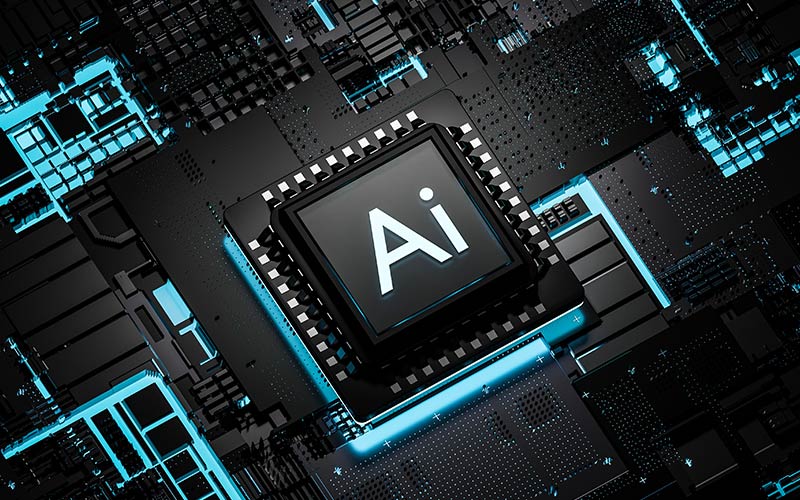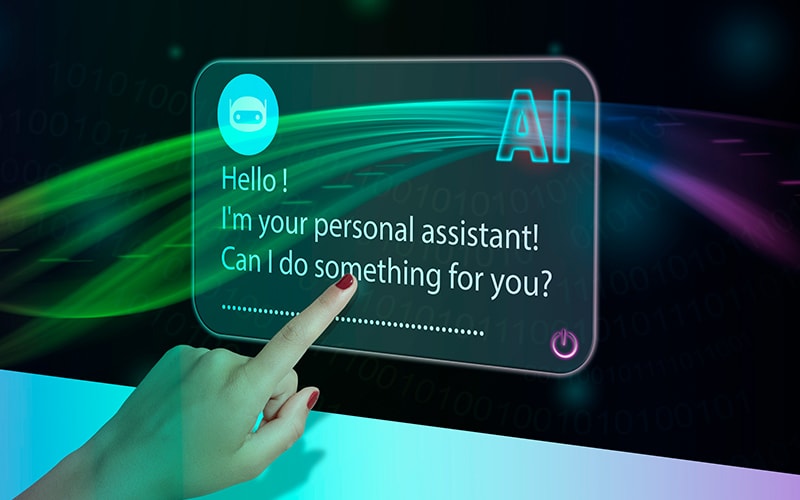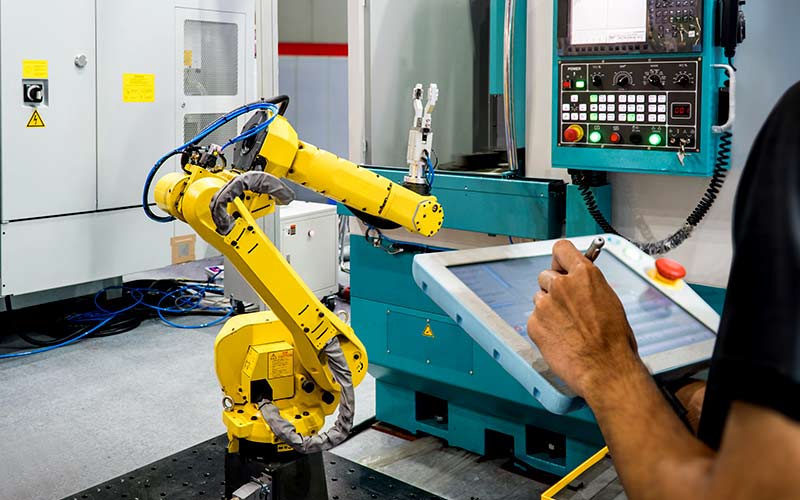Artificial intelligence (AI) has evolved rapidly in the past few years, and its use in industry has gathered pace too. First came predictive AI which was used in Amazon’s recommendations systems. Then deep learning algorithms were used in object and speech detection by governments across the world. This year, the bleeding edge of AI involves generative AI, distributed learning, and AI systems that are explainable across the AI life cycle. Those firms that use AI well can increase enterprise profit by 38% and will help deliver $14 trillion of gross added value to corporations by 2035. 1
Where is this value coming from exactly? A lot of AI is being used to manage and automate IT infrastructure, glean new insights about customers, identify cyber threats, and even improve the hiring process. But more can be done. Leading AI organizations put the technology at the center of both their business and operating models, using it to discover, democratize and de-risk AI adoption. The hope here is that they will become both a knowledge- and data-driven organization, with agility built into their DNA so they can deliver better products, increase customer sentiment, and derive more value from their partner ecosystem. Indeed, better working capital management, superior handling of business risk, and a more lucrative supply chain are just some of the changes this sort of “live enterprise” can expect to foster. Further, by making AI a core tenet of productivity, the live enterprise can quickly sense changing business needs and evolve in response. The holy grail here is a seamless network of partners, suppliers, and customers who talk to each other in real time, intelligently, and at the speed of data. 2
The time is ripe for firms to jump-start this AI journey towards a live enterprise: digital data is abundantly available, the cost of computing is getting lower by the day and algorithms are becoming increasingly sophisticated. However, most companies haven’t made this AI-first leap as of yet, with the majority using AI to merely increase efficiencies rather than transform the way business makes money. In fact, during the development of Infosys applied AI, they found the problem is that AI done right is not an easy thing, even for well-established firms that make agile, effective governance and an AI-first corporate vision a mainstay of competitive advantage. 3
In our research on 690+ corporates across 150 quantitative business metrics, the main obstacles on the journey to AI supremacy, even for leading firms, are finding effective talent, a risk-averse culture, and the difficulty of integrating AI technologies with legacy systems (Figure 1).
Figure 1. Challenges all firms are facing as they adopt AI
Source: Infosys
But breaking through this glass ceiling is worth the effort. In our analysis, we found that AI-first enterprises increase operating margins by as much as 3 percentage points as they progress along their AI journey, with the effect being highest in BFSI and consumer, retail and logistics (CRL) industries (Figure 2). For a banking firm in the U.S. operating with revenues of $10 billion, this means an extra $300 million in added revenues — no small figure.
AI-first enterprises increase operating margins by as much as 3 percentage points as they progress along their journey
Our AI maturity index scored respondent firms on a scale of 0–100 across dimensions of strategy; technology; operations; and talent and organization (T&O). Firms fell into one of four categories – “watchers”, “explorers”, “performers”, “visionaries” – depending on the respondents’ self-analysis to questions like “How many AI-related technologies has your company brought to scale in the last 12 months?” and “Do you have an enterprise-wide AI strategy in place?” Watchers were laggard AI firms that made up 18% of the data, and had an average AI maturity index of 30.13 (Figure 3), whereas leading ‘visionary’ firms (8% of the data) had an average score of 94.2. Even though scores were given based on self-analysis, some key insights emerged.
Figure 2. Leaders in AI increase operating margins by as much as 3 percentage points
Source: Infosys
Figure 3. Visionaries are ahead in operations, though improvement is still needed in talent and organization (T&O)
Source: Infosys Note: Maturity score: 0–100, Strategy, Technology, Operations, T&O: 0–5
Visionaries are much more effective at operations than other firms and exactly a third more competent in this dimension than “performers” (4.8 compared with 3.6). However, even within visionary organizations, improvement is possible in the area of T&O, receiving a score of 3.91 out of 5 — a full one point less than their score for technology. Still, as we will see in further analysis, even within this area, visionaries are far ahead of laggards with respect to effective change management processes and their ability to satisfy employees.
On the technology dimension, the more advanced companies had brought more AI-related technologies to scale, including IoT and drones, whereas the rest were still stuck in PoC or pilot mode across most initiatives (Figure 4).
Figure 4. Visionaries are operating at scale for more than nine-tenths of AI initiatives
Source: Infosys
Visionaries also cited more drivers for their AI journey, with key mandates to use AI and automation to reimagine processes, build strong AI governance, use AI to change business models, and bring disparate business units together in cross-functional teams (69% of visionaries on average, compared with 36% across all other firms) (Figure 5).
Figure 5. Visionaries are far ahead in terms of AI automation, governance, and innovation
Source: Infosys
We also found that digital natives such as Google and Facebook outperform digital immigrants (traditional companies beginning to add digital competencies) in their AI journey, with a significantly higher AI maturity index (Figure 6).
Figure 6. Digital natives have a significantly higher maturity index than digital immigrants
Source: Infosys
Focusing on governance and the employee
To increase operational effectiveness, operating margins need to grow. Further, effective governance needs to be put in place to both make AI more transparent and ensure strategy is carried out effectively. Three interesting themes related to operational effectiveness were found in our data, namely, AI ethics, employee satisfaction, and employee reskilling. Done right, these themes collectively improve business resilience and make a firm more profitable:
Focussing on both the employee and the customer can increase operating margins by 2 percentage points
- Focusing on AI ethics correlates with a higher maturity index, with visionaries outperforming performers by 25%.
- By focusing on the employee and the customer, operating margins can be increased by 2 percentage points.
- The ability to reskill the workforce sets leaders apart, with a 1 percentage point increase in operating margin compared with the rest of the group.
The people aspect of AI transformation is therefore a key attribute of success. According to experts at Korn Ferry, 99 percent of strategy is down to execution, which in turn is dependent on a highly skilled ecosystem of readily-available talent. For clients to launch their own AI-enablement journey (discussed below), and as part of our own AI maturity assessment, Korn Ferry will lend their expertise to audit firms across the four “people strategy” aspects of organization, talent, change management and culture. (Figure 7)
Figure 7. The Korn Ferry maturity audit looks at firms across four “people strategy” dimensions
| Organizational Structure Audit | Talent Audit | Change Management | Culture |
|---|---|---|---|
| Examining and designing the organization structure, as firms embrace more M2M than H2M workflow. In this paradigm, automated networks and algorithms run core operations. | Assessing the incumbent talent pool for skills and capabilities required within a ‘Live’ Enterprise. | Assessing the ability to reskill talent within the incumbent enterprise, with an emphasis on solution design, program and change management. | Define the culture that will drive growth and engage people at all levels of the organization. |
Source: Korn Ferry
Today’s business exists in a complex and unpredictable environment. The sheer volume and speed of change is so impactful that without careful attention it can disrupt and even derail business strategy.
Consequently, transforming the business requires identifying potential gaps in organization structure, people and culture. This means gaining clarity on how well the organization is set up to implement its AI strategy, raising questions such as:
- How well is the organization aligned with its strategy, especially in this new era of AI?
- Is the AI strategy aligned with the purpose of the organization?
- Is the right talent in place?
- Do employees understand the firm’s strategy?
- Is the strategy and culture of the firm aligned?
Bringing together the components of operational effectiveness (increased operating margins, effective AI governance) and business resilience (better AI ethics, increased employee satisfaction, employee upskilling), it is possible to draw a framework that surfaces further insights.
Key component areas across these dimensions that related to our data were found, including effective change management, knowledge sharing, and the use of external partners (Figure 8).
Figure 8. To increase operational effectiveness and business resilience, firms should concentrate on democratizing AI and change management
Source: Infosys
Effective change management is necessary to look after employees and ensure AI systems are accountable. From our data, we found that 96% of visionaries have effective change management processes in place, compared with 57% of explorers and just 32% of watchers (Figure 9).
At Infosys, the Live Enterprise initiative is putting employee satisfaction at the center of both business and operating models. Using applied AI, automated processes decrease resolution time for day-to-day tasks. Connected data across the enterprise and the wider ecosystem makes sure that all data is combined physically (through a knowledge graph), curated, cleansed, and connected in an automated manner. New insights are derived from this web of connections, which then become business drivers to provide ever-expanding services to positively impact the triple bottom line of people, profit, and planet. This platform also ensures that data and analytics are democratized through knowledge sharing portals. In time, the initiative will be implemented across partner organizations.
Figure 9. Leading firms have better change management and care more about employees
Source: Infosys
Democratizing AI or upskilling?
Making the workforce happier is one thread that emerges from the data. Being able to reskill talent to make use of advanced AI (H3 algorithms, in Infosys parlance), is also critical.
As we wrote in our report on Digital Radar 2020, it is far easier to become an explorer than it is to become a visionary firm. The main reason for this is inadequate skills. The same holds true for this analysis. Even though visionaries struggled most on the T&O dimension (Figure 1), lack of talent is much more pronounced for the rest of the group (35% said that lack of talent was a major challenge compared with just 9% of visionaries). One of the reasons for this is that visionaries have developed in-house expertise to deliver AI technologies (91%), whereas laggards depend on external support (69%) (Figure 10).
Figure 10. Nine-tenths of visionaries have developed in-house competency, whereas seven-tenths of the rest depend on external support
Source: Infosys
Companies can thwart this talent shortage in one of two ways: either by upskilling or by making AI easier to use. Sixty-three percent of visionaries have an organizational mandate and leadership drive to upskill employees (Figure 11), with many using a digital platform such as Wingspan (Infosys) or Maxis (General Motors) 4 to ensure always-on learning is available. This number falls to 15% for watchers, a significant difference.
Figure 11. Anywhere, anytime learning is much stronger for visionaries than for watchers
Source: Infosys
Making AI easier to use is often a better strategy in the long term as it has the knock-on effect of bringing business and IT together earlier on in the AI journey, rather than trusting a few superstar data scientists with developing capabilities. Visionaries do this very effectively, sharing data science knowledge throughout the organization 17 percentage points more rigorously than performers in our study.
Whether upskilling or making AI easier to use, the pace of change of technology means that employees will need to be given space to learn, unlearn and re-learn. Even simple and intuitive user interfaces that are powered by AI require a cohort of employees that ask the right questions at the right time. In this organizational set-up, employees across the spectrum will need to play both interlocutor and teacher, providing a space where AI-related questions are answered in confidence, and learnings up-voted at scale. To aid in this, AI training sessions should no longer act as a one-way monologue, but rather act as a platform to test new ideas and processes throughout the firm. These sessions will also be best served as an iterative and exploratory canvass for discussion, held throughout the year to act as a funnel for emerging ideas, while allowing less tech-savvy employees to upgrade their understanding. However, while anytime, anywhere learning will make these sessions more viable, the role of teacher will grow in importance; wherever possible, firms must introduce AI tutors, helping listeners interpret, question and analyze the content under discussion.
Getting operations right through a center of excellence
The data also shows that companies don’t do operations well enough, an area ripe for external support. And the money to be made here is vast. Organizations leading in AI operations, including greater in-house competency to scale AI technologies and the ability to work effectively across siloes, outperformed the rest by as much as 6 percentage points of the operating margin (Figure 12). To put that into a dollar figure, that’s $600 million extra cash for a $10 billion revenue company.
Figure 12. Effective AI operations can increase operating margins by up to 6 percentage points
Source: Infosys
That said, even visionaries cite legacy systems, a risk-averse culture, and inadequate business/IT collaboration as their biggest challenges in carrying out effective operations strategy. These problems are not just AI problems. In fact, when we asked our cloud experts to name the main reasons for setting up a Cloud Center of Excellence — along with an overwhelming number of solutions to choose from and inflated expectations from a cloud journey — the ultimate reason was the desire to increase governance and reduce costs by bringing together technology, finance, and business teams under one umbrella. Visionary firms can optimize their investments by setting up a hub for stakeholder engagement, which will align the organization on the best way to make use of talent, CapEx, and OpEx spending. This structure can also be used by laggard firms to train employees, institute effective change management, and ensure that AI within the firm lives up to the hype.
Your own maturity assessment
COVID-19 has accelerated the implementation of AI initiatives, with firms doing more work in six months than they might have done in years. In this new paradigm, the employee has become the linchpin on which success will depend. Getting change management right and ensuring the workforce is engaged can massively impact the bottom line.
Before a firm can put in place an effective playbook for how to become more like a visionary organization, it is necessary to first determine the as-is state. At Infosys and Korn Ferry, we have developed a tool for firms to do just that. Using an online portal, executives will be asked a series of questions that will score their firm across our maturity indices. Along with a performance scorecard and industry benchmark, they will then be provided with a high-level roadmap with a set of prioritized capabilities to launch their applied AI enablement journey. Further, a dollar figure will be assigned to the impact that this journey will have on their bottom line (increased revenues, cost benefits) over a defined time horizon.
AI is changing business right now. With Infosys applied AI, we are helping enterprises scale and future-proof their AI-powered investments. Are you ready to come along on the journey?
Interested in taking the assessment? Email saibal.samaddar@infosys.com or tristan.schulhof@infosys.com.
Methodology
We studied the AI journey of 690+ organizations, analyzing 200+ quantitative and qualitative metrics. Maturity indices were derived by scoring firms from 0 to 100 across the four dimensions of strategy, technology, operations, and T&O (Watchers, Explorers, Performers, Visionaries).
The respondents were C-suite executives, directors, SVPs, VPs, and AVPs.
The split of firms across sector, geography, digital tenure, and revenue bands was as follows:
References
- Implementing AI in Business – Challenges and Resolutions, Harry Keir Hughes & Isaac Labauve, November 2019, Infosys Knowledge Institute
- Infosys Live Enterprise – A Continuously Evolving and Learning Organization, Mohammed Rafee Tarafdar, Jeff Kavanaugh & Harry Keir Hughes, July 2019, Infosys Knowledge Institute
- Infosys Digital Radar 2020: From digital maturity to living enterprise, Jeff Kavanaugh & Chad Watt, 2020, Infosys Knowledge Institute
- Agile-Powered Data Intelligence: Reinventing Business, Dr. N.R. Srinivasa Raghavan & Harry Keir Hughes, June 2020, Infosys Knowledge Institute
About Infosys Consulting
Infosys Consulting is a consulting firm with a difference. As innovation and digital transformation partner, we offer our clients deep industry expertise and end-to-end solutions to solve today’s most pressing, multi-dimensional challenges. Sitting at the intersection of industry strategy and cutting-edge technology, our consultants lead industrialization solutions at scale and implement complex change programs where the human element becomes the true differentiator for success. And with the ability to execute at scale, we transform ingenious ideas into operational reality through our delivery power of Infosys.
About Korn Ferry
Korn Ferry is a global organizational consulting firm. We work with clients to design their organizational structures, roles, and responsibilities. We help them hire the right people and advise them on how to reward, develop, and motivate their workforce. And, we help professionals navigate and advance their careers.


















